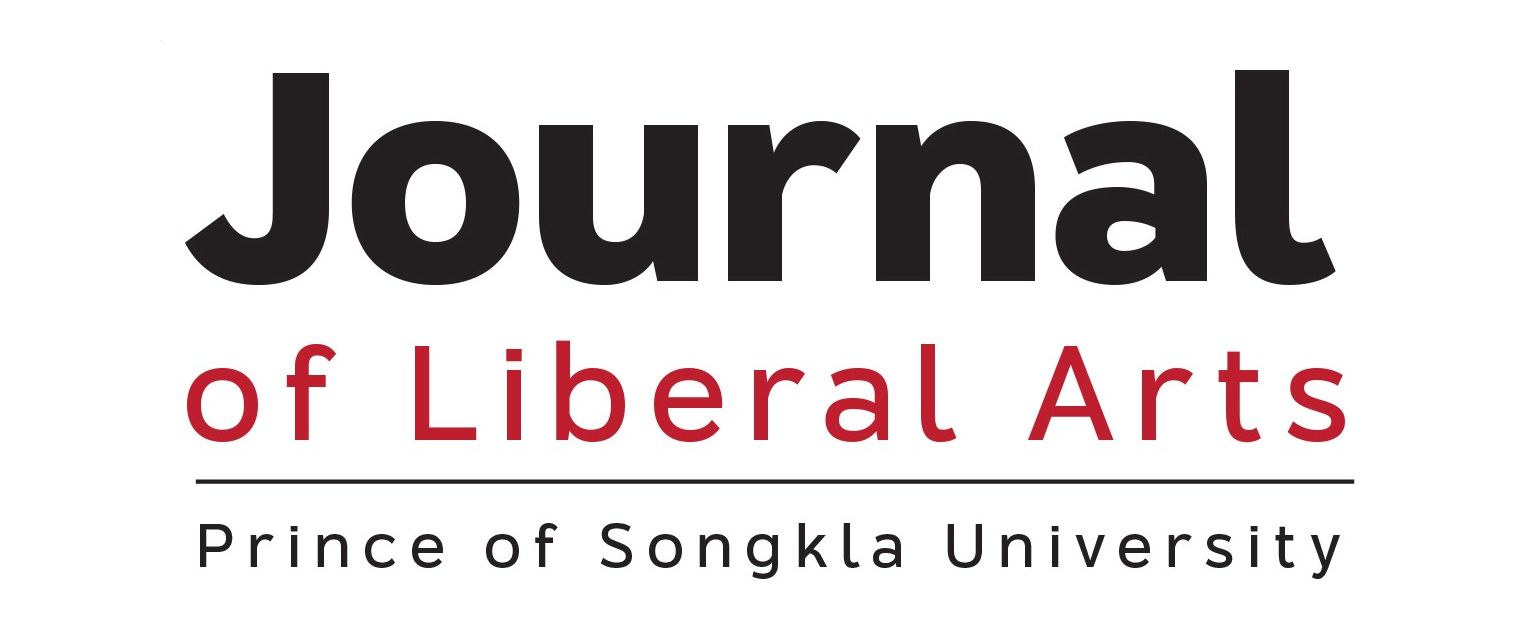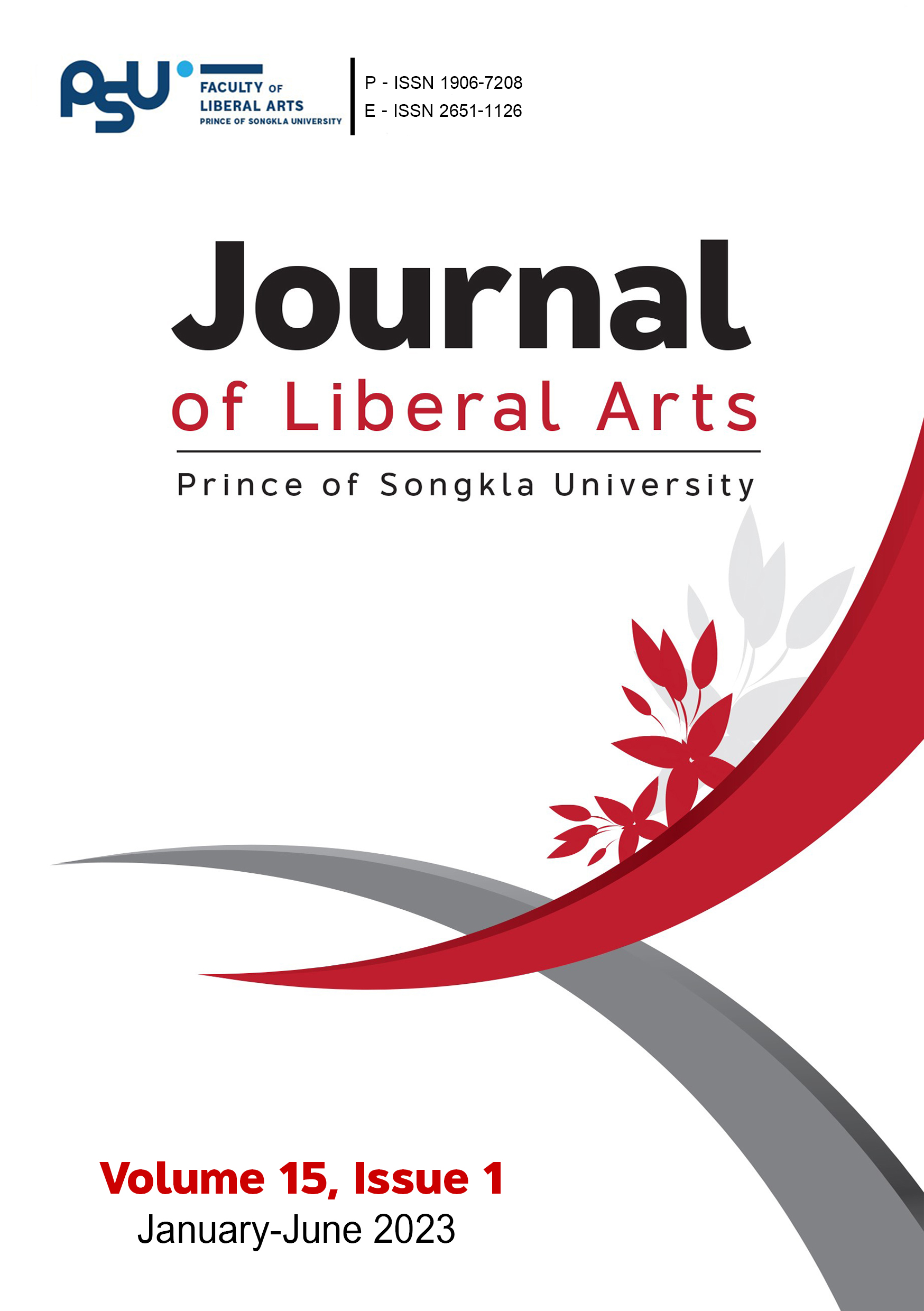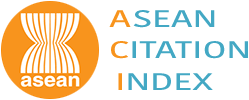ความสามารถทางภาษาอังกฤษและทัศนคติของนักศึกษาไทย ต่อการสอนโดยใช้ภาษาอังกฤษเพียงอย่างเดียว และการสอนโดยใช้สองภาษา
DOI:
https://doi.org/10.14456/jlapsu.2023.8คำสำคัญ:
การเรียนรู้ภาษาที่ 2 , การสอนโดยใช้สองภาษา , การสอนโดยใช้ภาษาอังกฤษเพียงอย่างเดียวบทคัดย่อ
การศึกษาการสอนโดยใช้ภาษาอังกฤษเป็นสื่อในการสอนเพียงอย่างเดียวเป็นที่ได้รับความสนใจในสาขาการสอนภาษาอังกฤษ ทว่าการใช้ภาษาแรกของผู้เรียนในห้องเรียนยังเป็นประเด็นที่มีการถกเถียงอยู่มาก จากการสืบค้นพบว่าปัจจุบันงานที่ศึกษาเกี่ยวการสลับระหว่างภาษาอังกฤษและภาษาไทยส่วนใหญ่เน้นไปที่ทัศนคติของครูและผู้เรียนที่มีต่อการใช้ภาษาแรกมากกว่าการเปรียบเทียบความสามารถทางภาษาอังกฤษของผู้เรียนทั้งสองวิธีสอน ดังนั้นงานวิจัยนี้จึงมุ่งศึกษาความสามารถทางภาษา ทัศนคติของผู้เรียน และสหสัมพันธ์ของความสามารถทางภาษาและทัศนคติของผู้เรียน ที่มีต่อการสอนโดยใช้ภาษาอังกฤษเพียงอย่างเดียวและสองภาษา โดยกลุ่มผู้เข้าร่วมงานวิจัย จำนวน 67 คน เป็นนักศึกษาชั้นปีที่ 1 มหาวิทยาลัยแม่ฟ้าหลวง ที่เรียนหลักสูตรภาษาอังกฤษเร่งรัด ผู้เข้าร่วมการวิจัยถูกแบ่งออกเป็น 2 กลุ่มคือกลุ่มควบคุม ที่สอนโดยการใช้ภาษาอังกฤษเป็นสื่อการสอนเพียงอย่างเดียว และกลุ่มทดลองที่สอนโดยการใช้ภาษาอังกฤษและภาษาไทยเป็นสื่อการสอน และเก็บข้อมูลโดยใช้แบบทดสอบวัดระดับความรู้ภาษาอังกฤษ และแบบทดสอบทัศนคติทางภาษาก่อนและหลังเรียน ผลการทดลองบ่งชี้ว่าค่าเฉลี่ยของคะแนนวัดระดับความรู้ภาษาอังกฤษก่อนและหลังเรียนของกลุ่มควบคุมไม่มีความแตกต่างที่นัยสำคัญทางสถิติ (X1= 5.16, 5.79) แต่กลุ่มทดลองมีระดับคะแนนเฉลี่ยภาษาอังกฤษหลังเรียนสูงกว่าก่อนเรียน (X2= 4.95, 6.45). สำหรับการประเมินทัศนคติทางภาษา พบว่ากลุ่มควบคุม มีทัศนคติเชิงบวกที่เพิ่มขึ้นหลังเรียน (X1= 10.32, 11.50) และกลุ่มทดลองมีทัศนคติเชิงบวกต่อการใช้ภาษาแรกคงที่ตลอดระยะเวลาการเรียน (X2= 10.65, 11.32) ทั้งนี้ พบว่าความสามารถทางภาษาและทัศนคติของผู้เรียนมีค่าสหสัมพันธ์เชิงบวก (r = 1.00, p = .01) กล่าวคือ ทัศนคติที่ผู้เรียนมีต่อการใช้ภาษาในห้องเรียนส่งผลต่อความสามารถทางภาษาของผู้เรียน ข้อค้นพบเหล่านี้บ่งชี้ว่าการใช้ภาษาแรก (ภาษาไทย) ในห้องเรียนภาษาต่างประเทศ (ภาษาอังกฤษ) หากใช้อย่างเหมาะสมจะเป็นเครื่องมือที่เป็นประโยชน์สำหรับผู้เรียน
เอกสารอ้างอิง
Abe, Y. (2011). Perceptions of bilingual teachers by teachers and students. Second language Studies, 29(2), 61-106.
Atkinson, D. (1987). The mother tongue in the classroom: A neglected resource? ELT Journal, 41(4), 241-247. https://doi.org/10.1093/elt/41.4.241
Auerbach, E. (1993). Reexamining English only in the ESL classroom. TESOL Quarterly, 27(1), 9-32. https://doi.
org/10.2307/3586949
Bhela, B. (1999). Native language interference in learning a second language: Exploratory case studies of native language interference with target language usage. International Educational Journal, 1(1), 22-60.
Brooks, F., & Donato, R. (1994). Vygotskyan approaches to understanding foreign language learner discourse during communicative tasks. Hispania, 77(2)262-274. https://doi.org/10.2307/344508
Brooks, K. (2009). Adult Learners’ Perceptions of the Incorporation of their L1 in Foreign Language Teaching and Learning. Applied Linguistics, 30(2), 216-235. https://doi.org/10.1093/applin/amn051
Campa C. J. & Nassaji, H. (2009). The Amount, Purpose, and Reasons for Using L1in L2 Classrooms. Foreign Language Annals, 42(2), 742- 759. https://doi.org/10.1111/j.1944-9720.2009.01052.x
Cook, V. (2001). Using the first language in the classroom. Canadian Modern Language Review, 57(3), 402–423. https://doi.org/10.3138/cmlr.57.3.402
Cook, V. (2002). Background to the L2 user. In V. Cook (ed.), Portraits of the L2 User Z (pp.1-28). SLA.
Cummins, J. (1978). Bilingualism and the development of metalinguistic awareness. Journal of cross-cultural psychology, 9(2) 131-149. https://doi.org/10.1177/002202217892001
De La Campa, J., & Nassaji, H. (2009). The amount, purpose, and reasons for using L1 in L2 classrooms. Foreign language annals, 742-759. https://doi.org/10.1111/j.1944-9720.2009.01052.x
Dörnyei, Z. (2007). Research Methods in Applied Linguistics. Oxford University Press.
Ellis, R. (1985). Understanding Second Language Acquisition. Oxford University Press.
Ellis, R. (1997). Second language acquisition. Oxford.
Ellis, R. (2008). The study of second language acquisition. Oxford University Press.
Enama, P. (2016). The impact of English-only and bilingual approaches to EFL instruction on low-achieving bilinguals in Cameroon: An empirical study. Journal of Language Teaching and Research, 7, 19-30.
Ford, K. (2009). Principles and Practices of L1/ L2 Use in the Japanese University EFL Classroom. JALT Journal, 31(1), 63-80.
Gaebler, P. (2014). L1 use in FL classrooms: Graduate students’ and professors’ perceptions of English use in foreign language courses. CATESOL Journal, 25(1), 66-94.
Gajšt, N. (2017). Students’ attitudes towards the use of Slovene as L1 in teaching and learning of Business English at tertiary level. ELOPE: English Language Overseas Perspectives and Enquiries, 14(1), 95-112. https://doi.org/10.4312/elope.14.1.95-112
Gardner, R. C., & Lambert, W. E. (1972). Attitudes and motivation in second language learning. Rowley, Mass: Newbury House Publishers.
Gardner, R.C., & Lalonde, R.N., & Moorcroft, R. (1985). The role of attitudes and motivation in second language learning:Correlational and experimental considerations.
Language Learning, 35(2), 207-227. https://doi.org/10.1111/j.1467-1770.1985.tb01025.x
Jaliyya, F., & Idrus, F. (2017). EFL students’ attitudes and perception towards English language learning and their English language proficiency: a study from Assa’adah Islamic Boarding School, Indonesia. Journal of Education and Learning (EduLearn), 11(3), 219-228. https://doi.org/10.11591/edulearn.v11i3.4621
Krashen, S. D. (1985). The input hypothesis: Issues and implications. Addison-Wesley Longman Limited.
Krashen, S. (1988). On course: Bilingual education's success in California. California Association for Bilingual Education.
Krashen, S. (1989). We acquire vocabulary and spelling by reading: additional evidence for the input hypothesis. Modem Language Journal, 73(4), 440-464. https://doi.org/10.2307/326879
Lee, J., & Lo, Y. (2017). An exploratory study on the relationships between attitudes toward classroom language choice, motivation, and proficiency of EFL learners. System, 67, 121-131. https://doi.org/10.1016/j.system.2017.04.017
Macaro, E. (1997). Target language, collaborative learning and autonomy. Multilingual Matters.
Macaro, E. (2001). Analyzing student teachers’ code-switching in foreign language classrooms: Theories and decision making. The Modern Language Journal, 85(4), 531–548. https://doi.org/10.1111/0026-7902.00124
Machaal, B. (2012). The Use of Arabic in English classes: a teaching support or a learning hindrance? Arab World English Journal, 3(2), 194-232.
Masgoret, A., & Gardner, R. (2003). Attitudes, motivation, and second language learning: A meta‐analysis of studies conducted by Gardner and associates. Language learning, 53(1), 167-210. https://doi.org/10.1111/1467-9922.00227
Mirza, G., Mahmud, K., & Jabbar, J. (2012). Use of other languages in English language teaching at tertiary level: a case study on Bangladesh. English Language Teaching, 5(9), 71-77.
Meyer, H. (2008). The pedagogical implications of L1 use in the L2 classroom. Maebashi Kyoai Gakuen College Ronsyu, 8, 147-159.
Nazary, M. (2008). The Role of L1 in L2 Acquisition: Attitudes of Iranian University Students. Novitas-ROYAL (Research on Youth and Language), 2(2), 138-153.
Ocak, G., Kuru N., Özçalışan, H. (2010). As a classroom language, students’ attitudes towards speaking Turkish in English prep classes. Procedia Social and Behavioral Sciences, 2, 661-665. https://doi.org/10.1016/j.sbspro.2010.03.080
Odlin, T. (1989). Language transfer: Cross-linguistic influence in language learning. Cambridge University Press.
Prodromou, L. (1992). What culture? Which culture? Cross-cultural factors in language learning. ELT Journal, 46(1), 39-50. https://doi.org/10.1093/elt/46.1.39
Richards, J. C., & Rodgers, T. S. (2014). Approaches and methods in language teaching. Cambridge university press.
Sarıçoban, A. (2010). Should native language be allowed in foreign language classes? Eurasian Journal of Educational Research (EJER).
(38). 164-178.
Simsek, R. M. (2010). The effects of L1 use in the teaching of L2 grammar concepts on the students’ achievement. Journal of Theory and Practice in Education, 6(2)142-169.
Thongwichit, N. (2013). L1 use with university students in Thailand: a facilitating tool or a language barrier in learning English? Silpakorn University Journal of Social Sciences, Humanities, and Arts, 13(2), 179-206.
Tian, L., & Hennebry, M. (2016). Chinese learners' perceptions towards teachers' language use in lexical explanations: A comparison between Chinese-only and English-only instructions. System, 63, 77-88. https://doi.org/10.1016/j.system.2016.08.005
Trakulkasemsuk, W., & Ketwandee, T. (2013). Teacher talk in English classroom: L1 or L2 [Proceesing]. The 9th International Conference on Humanities and Social Sciences, Khon Kaen University, Thailand
Zeinivand, T., Azizifar, A., & Gowhary, H. (2015). The relationship between attitude and speaking proficiency of Iranian EFL learners: The case of Darrehshehr city. Procedia-Social and Behavioral Sciences, 199, 240-247. https://doi.org/10.1016/j.sbspro.2015.07.512
Zhao, T., & Macaro, E. (2016). What works better for the learning of concrete and abstract words: teachers' L 1 use or L 2‐only explanations? International Journal of Applied Linguistics, 26(1), 75-98. https://doi.org/10.1111/ijal.12080
ดาวน์โหลด
เผยแพร่แล้ว
รูปแบบการอ้างอิง
ฉบับ
ประเภทบทความ
สัญญาอนุญาต
ลิขสิทธิ์ (c) 2023 Hathaichanok Wansong

อนุญาตภายใต้เงื่อนไข Creative Commons Attribution-NonCommercial-NoDerivatives 4.0 International License.
ลิขสิทธิ์บทความเป็นของผู้เขียน แต่วารสารศิลปศาสตร์ มหาวิทยาลัยสงขลานครินทร์ ขอสงวนสิทธิ์ในการเป็นผู้ตีพิมพ์เผยแพร่เป็นครั้งแรก






